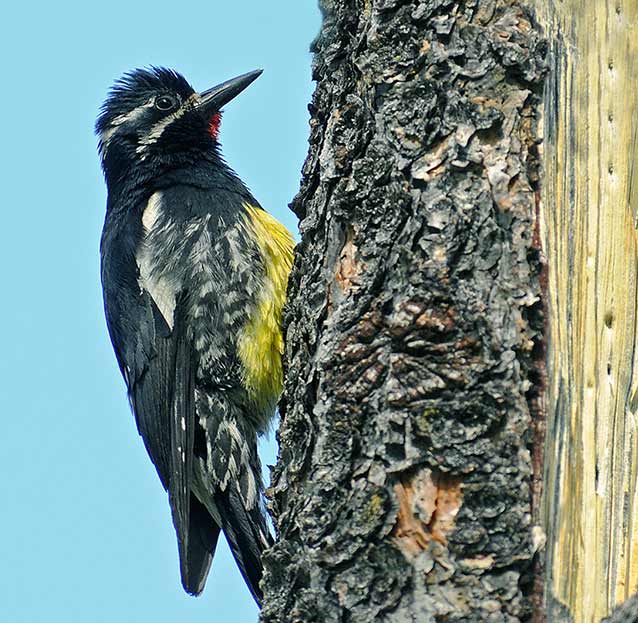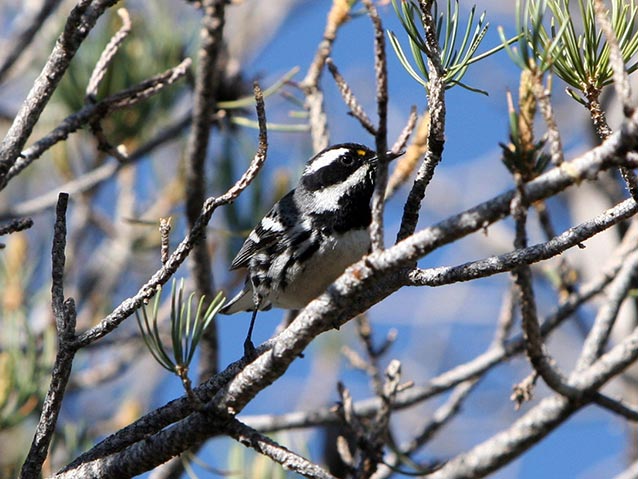Bird communities can tell us a lot about changing environmental conditions. High on the food chain, and sensitive to climate and habitat changes, birds are monitored on the Southern Colorado Plateau as indicators of riparian and upland ecosystem health.

Photo by Sally King, NPS.
Because of their high body temperature, rapid metabolism, and high position in most food webs, birds were selected for monitoring as an indicator of the overall condition of upland and riparian ecosystems in the Southern Colorado Plateau Inventory and Monitoring Network. Birds are also sensitive to changes in habitat and climate, making them good indicators of the effects of local and regional changes to ecosystems, such as grazing, air pollution, and climate change. Many bird species are obligates in habitats that are widely distributed across the southern Colorado Plateau, and some of these species and habitats are of conservation concern. The relatively natural habitats found in the Southern Colorado Plateau Network (SCPN) parks can serve as reference sites for degraded habitats on adjacent lands.
Long-term Monitoring

Photo by Kenneth Bergman, https://www.flickr.com/photos/8561740@N08/
Several habitats where bird communities are being monitored are also being monitored for the condition of upland and riparian areas. In this way, information on the status and trends of bird communities contributes to our overall understanding of ecosystem condition. Bird-community monitoring consists of breeding-season surveys that employ variable circular plot methodology. At each sampling point, an eight-minute survey is performed. Visual or auditory detections of birds are recorded, along with the distance from the point to the first detection of an individual. The condition of the habitat is also monitored with measurements of ground cover, canopy closure, vegetation cover by functional groups (e.g., shrubs, perennial grasses, forbs), and forest-structure attributes.
Management Applications
Ecological effects of adjacent land-use activities, such as livestock grazing, forest management, water diversion, urban/exurban development, and emissions of industrial and agricultural pollutants are of concern across SCPN parks. One result may be that species that are widely distributed and do not have stringent habitat requirements will increase, while species with narrow habitat requirements will decrease. Because birds need wide-ranging habitat for breeding, migration, and wintering, climate change is expected to affect migratory birds differently than many other vertebrates. Climate change is already altering habitat availability and shifting the ranges and the timing of life-cycle events for some birds.
SCPN park units and habitat where bird communities will be monitored | |
Park | Habitat |
Bandelier NM | Mixed conifer |
Canyon de Chelly NM | Riparian |
Grand Canyon NP | Mixed conifer, pinyon-juniper |
Mesa Verde NP | Pinyon-juniper |
Petrified Forest NP | Grassland |
Wupatki NM | Grassland |
The first few years of monitoring data will be used to document current conditions of habitat-based bird communities. Over the long term, the data will be used to (1) determine status and trends in composition and abundance of breeding bird communities associated with selected upland and riparian ecosystems, and (2) improve our understanding of breeding bird-habitat relationships in these ecosystems.
Contact
Prepared by the Southern Colorado Plateau Network Inventory & Monitoring Program, 2012.
Tags
- bandelier national monument
- canyon de chelly national monument
- grand canyon national park
- mesa verde national park
- petrified forest national park
- wupatki national monument
- swscience
- american southwest
- southern colorado plateau
- birds
- landbirds
- science
- project
- monitoring
- scpn
- jmrlc
- natural resources
- wildlife
Last updated: January 12, 2023
